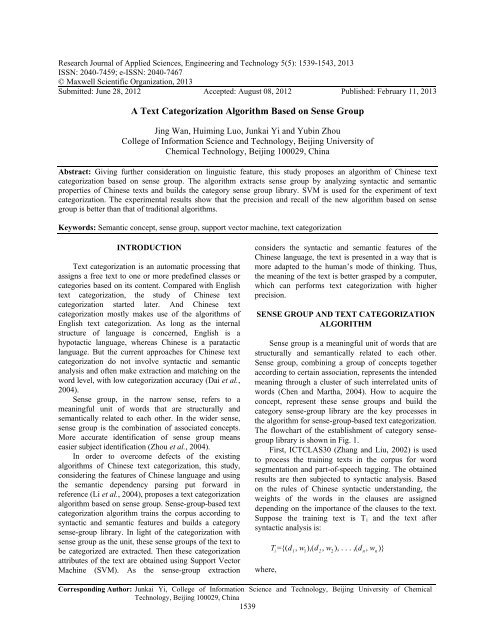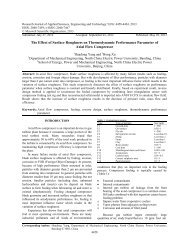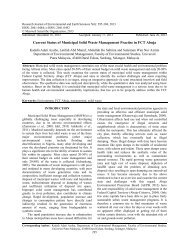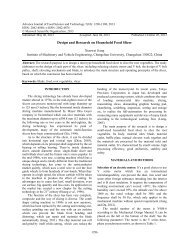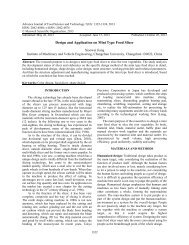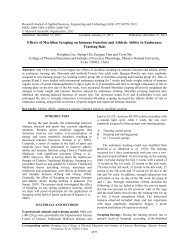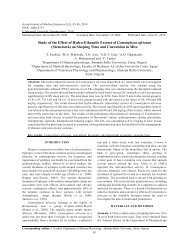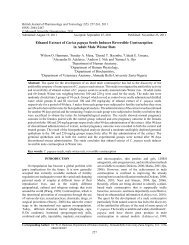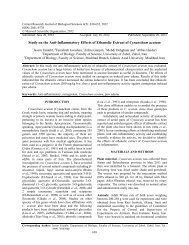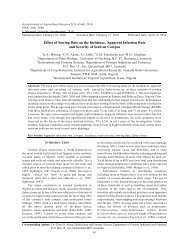View PDF - Maxwell Science
View PDF - Maxwell Science
View PDF - Maxwell Science
Create successful ePaper yourself
Turn your PDF publications into a flip-book with our unique Google optimized e-Paper software.
Research Journal of Applied <strong>Science</strong>s, Engineering and Technology 5(5): 1539-1543, 2013<br />
ISSN: 2040-7459; e-ISSN: 2040-7467<br />
© <strong>Maxwell</strong> Scientific Organization, 2013<br />
Submitted: June 28, 2012 Accepted: August 08, 2012 Published: February 11, 2013<br />
A Text Categorization Algorithm Based on Sense Group<br />
Jing Wan, Huiming Luo, Junkai Yi and Yubin Zhou<br />
College of Information <strong>Science</strong> and Technology, Beijing University of<br />
Chemical Technology, Beijing 100029, China<br />
Abstract: Giving further consideration on linguistic feature, this study proposes an algorithm of Chinese text<br />
categorization based on sense group. The algorithm extracts sense group by analyzing syntactic and semantic<br />
properties of Chinese texts and builds the category sense group library. SVM is used for the experiment of text<br />
categorization. The experimental results show that the precision and recall of the new algorithm based on sense<br />
group is better than that of traditional algorithms.<br />
Keywords: Semantic concept, sense group, support vector machine, text categorization<br />
INTRODUCTION<br />
Text categorization is an automatic processing that<br />
assigns a free text to one or more predefined classes or<br />
categories based on its content. Compared with English<br />
text categorization, the study of Chinese text<br />
categorization started later. And Chinese text<br />
categorization mostly makes use of the algorithms of<br />
English text categorization. As long as the internal<br />
structure of language is concerned, English is a<br />
hypotactic language, whereas Chinese is a paratactic<br />
language. But the current approaches for Chinese text<br />
categorization do not involve syntactic and semantic<br />
analysis and often make extraction and matching on the<br />
word level, with low categorization accuracy (Dai et al.,<br />
2004).<br />
Sense group, in the narrow sense, refers to a<br />
meaningful unit of words that are structurally and<br />
semantically related to each other. In the wider sense,<br />
sense group is the combination of associated concepts.<br />
More accurate identification of sense group means<br />
easier subject identification (Zhou et al., 2004).<br />
In order to overcome defects of the existing<br />
algorithms of Chinese text categorization, this study,<br />
considering the features of Chinese language and using<br />
the semantic dependency parsing put forward in<br />
reference (Li et al., 2004), proposes a text categorization<br />
algorithm based on sense group. Sense-group-based text<br />
categorization algorithm trains the corpus according to<br />
syntactic and semantic features and builds a category<br />
sense-group library. In light of the categorization with<br />
sense group as the unit, these sense groups of the text to<br />
be categorized are extracted. Then these categorization<br />
attributes of the text are obtained using Support Vector<br />
Machine (SVM). As the sense-group extraction<br />
considers the syntactic and semantic features of the<br />
Chinese language, the text is presented in a way that is<br />
more adapted to the human’s mode of thinking. Thus,<br />
the meaning of the text is better grasped by a computer,<br />
which can performs text categorization with higher<br />
precision.<br />
SENSE GROUP AND TEXT CATEGORIZATION<br />
ALGORITHM<br />
Sense group is a meaningful unit of words that are<br />
structurally and semantically related to each other.<br />
Sense group, combining a group of concepts together<br />
according to certain association, represents the intended<br />
meaning through a cluster of such interrelated units of<br />
words (Chen and Martha, 2004). How to acquire the<br />
concept, represent these sense groups and build the<br />
category sense-group library are the key processes in<br />
the algorithm for sense-group-based text categorization.<br />
The flowchart of the establishment of category sensegroup<br />
library is shown in Fig. 1.<br />
First, ICTCLAS30 (Zhang and Liu, 2002) is used<br />
to process the training texts in the corpus for word<br />
segmentation and part-of-speech tagging. The obtained<br />
results are then subjected to syntactic analysis. Based<br />
on the rules of Chinese syntactic understanding, the<br />
weights of the words in the clauses are assigned<br />
depending on the importance of the clauses to the text.<br />
Suppose the training text is T i and the text after<br />
syntactic analysis is:<br />
where,<br />
T={( d , w ),( d , w ),...,( d , w )}<br />
i 1 1 2 2<br />
n n<br />
Corresponding Author: Junkai Yi, College of Information <strong>Science</strong> and Technology, Beijing University of Chemical<br />
Technology, Beijing 100029, China<br />
1539
Res. J. Appl. Sci. Eng. Technol., 5(5): 1539-1543, 2013<br />
Training<br />
texts<br />
Category sensegroup<br />
library<br />
Syntactic analysis module<br />
Semantic analysis module<br />
Word<br />
segmentation<br />
and part-ofspeech<br />
tagging<br />
Sentence type<br />
classification<br />
Weight<br />
assignment<br />
Semantic<br />
hierarchy<br />
analysis<br />
Part-of-speech<br />
choice<br />
Concept<br />
mapping<br />
Dimensionality<br />
reduction<br />
Fig. 1: Flowchart of the establishment of category sense-group library<br />
d i : A word<br />
w i : The weight of word<br />
Semantic hierarchy analysis is performed on the results<br />
of syntactic analysis with assigned weights.<br />
Considering semantic dependency in Chinese sentences<br />
(Li et al., 2004), text hierarchy is divided using<br />
semantic and structural analysis. Each hierarchy<br />
represents a sense group and thus the text now becomes<br />
a set of sense groups. As shown in Formula (1):<br />
Ti = { C1, C2, ⋅⋅⋅ , Cm} = {[( d1, w1) ,( d2, w2)... ,( dk,<br />
wk)],<br />
[( d , w ),...,( d , w )],[( d , w ),...,( d , w )]} 1<br />
k+ 1 k+ 1 l l l+ 1 l+<br />
1 n n<br />
where, k < l < n and C i is the sense group. Each sense<br />
group contains the words and the corresponding<br />
weights of words. Part-of-speech choice is performed<br />
on the words according to their contribution to text<br />
categorization. For effective words after part-of-speech<br />
choice, the concepts are extracted based on HowNet<br />
semantics and the words are mapped into the concept<br />
space. Then the sense group and the text can be<br />
represented as in Formula (2) and (3):<br />
1 1 2 2<br />
( )<br />
SenseGroup = {( t , w ),( t , w ),...,( t , w )} (2)<br />
Ti = {[( t1, w1) ,( t2, w2)... ,( tv, wv)],[( tv+ 1, wv+<br />
1) ,...,<br />
( t , w )],[( t , w ),...,( t , w )]}, v< j<<br />
sssssss(3)<br />
j j j+ 1 j+<br />
1 s s<br />
where, w i is the weight of concept t i . The first 20<br />
concepts arranged according to their weights are<br />
selected as effective concepts. After dimensionality<br />
reduction of sense groups, the texts are stored by text<br />
category and then the category sense-group library is<br />
obtained. Suppose the category sense-group library is<br />
SGC, then SGC = {C 1 , C 2 , …, C r }, where C i is a sense<br />
group, with each sense group C i having n characteristic<br />
values and, j = 1, 2,… as shown in Formula (4):<br />
C t w t w t w i rrrr<br />
1 1 2 2 n n<br />
i<br />
= {(<br />
i, i) ,( i<br />
,<br />
i<br />
)...,( i<br />
,<br />
i<br />
)}, = 1,2, ⋅⋅⋅, (4)<br />
With the sense-group category library obtained, the<br />
same procedures of sense-group extraction are repeated<br />
h<br />
h<br />
for text T i and the sense groups are represented by<br />
vectors. An appropriate categorization algorithm is<br />
identified between the text to be categorized and<br />
category sense-group library. A quantitative relation<br />
that can be recognized by the computer is used to<br />
determine the category of subject. That is, a mapping<br />
relation f is identified so that for ∀ Ti<br />
, we have<br />
f<br />
Ti<br />
⎯ ⎯→ C . By this approach, the text is categorized<br />
i<br />
while saving much time of manual categorization. This<br />
approach makes possible information processing and<br />
collection.<br />
MAIN MODULES AND THE TEXT<br />
CATEGORIZATION ALGORITHM<br />
Syntactic analysis module: It is theoretically believed<br />
that the varieties of sentences are infinite, but the types<br />
of sentences are finite. Any sentence is classified as<br />
basic sentence type or its combination. The major task<br />
of syntactic analysis module is to analyze the structure<br />
of the sentence and to identify the sentence type.<br />
Weights are assigned to sentences according to position<br />
of the sentence in the text, the degree of influence of<br />
syntax on general idea of the text and the key points of<br />
understanding clauses contained in the complex<br />
sentence. This process is crucial for the selection of<br />
concept features in establishing category sense-group<br />
library.<br />
Sentence type classification: Automatic chunk<br />
segmentation is used to classify sentence types as well<br />
as extract and identify syntactic structure and functional<br />
structure on the higher layer. The existing automatic<br />
chunk segmentation defines the chunk category from<br />
the perspective of syntactic concept (Li et al., 2003). By<br />
incorporating semantic concept into the definition of<br />
syntactic chunk, the grammatical rules are refined and<br />
collocation of the structures is constrained. In this way,<br />
the grammar and semantic are closely related. In this<br />
study, chunk category is divided into two layers,<br />
namely, phase element which is grammatical and<br />
functional elements which is semantic. Phrase elements<br />
include the common phase types: Adjective Phrase<br />
(ADJP), Adverb Phrase (ADVP), Location phrase<br />
1540
Res. J. Appl. Sci. Eng. Technol., 5(5): 1539-1543, 2013<br />
Table 1: Weight assignment to complex sentences<br />
Sentence type Processing strategy Weight assignment<br />
Coordinate complex sentence<br />
Coordinate complex sentence is divided into<br />
contrastive sentence and compound sentence.<br />
Increased weight is assigned to the second<br />
clause in the complex sentence, and reduced<br />
weight to the clause in the first part. The<br />
weight difference should not exceed 0.5. For<br />
compound sentence, the weights of the two<br />
clauses are equal.<br />
Progressive, transitional, conditional, causeand-effect,<br />
purposive complex sentence<br />
Increased weight is assigned to the second<br />
clause, whereas reduced weight is assigned to<br />
the first clause. The weight difference is 0.5.<br />
Explanatory complex sentence Increased weight is assigned to the<br />
explanatory clause; the weight of the<br />
remaining part is assigned according to the<br />
rules for ordinary sentences.<br />
Successive complex sentence<br />
Increased weight is assigned to the last clause;<br />
the weight of the remaining part is assigned<br />
according to the rules for ordinary sentences.<br />
Selective complex sentence<br />
Equal weights are assigned to the first and the<br />
second clauses.<br />
(IOC), Noun Phrase (NP), Preposition Phrase (PP),<br />
Quantifier Phrase (QP), Verb Phrase (VP); functional<br />
elements include Subject (SUB), direct Object (OBJ),<br />
Indirect Object (IOBJ) and Preposition Object (POBJ).<br />
The algorithm for sentence type identification<br />
adopts sentence type identification strategy based on<br />
rule matching. Guided by the syntactic rules of<br />
predicate knowledge base and linguistic statistics,<br />
sentence type matching is performed for sentence<br />
stems. The difficulty in sentence type classification is<br />
identification of complex sentences. We use automatic<br />
chunk segmentation to divide Chinese complex<br />
sentences into 9 categories: coordinate complex<br />
sentence, explanatory complex sentence, successive<br />
complex sentence, progressive complex sentence,<br />
selective complex sentence, transitional complex<br />
sentence, conditional complex sentence, cause-andeffect<br />
complex sentence and purposive complex<br />
sentence (Wen et al., 2008). Depending on the<br />
contribution of complex sentences to text<br />
understanding, we assign variable weights to complex<br />
sentences.<br />
Weight assignment: Generally speaking, the title of<br />
the text can best reflect the text category. Then the<br />
highest position weight is assigned to the title.<br />
After sentence type classification, the text is<br />
composed of complex sentences and simple sentences.<br />
In light of the degree of the influence of sentence<br />
structure and the rules of understanding Chinese<br />
complex sentences, we assign different weights to the<br />
complex sentences (Table 1). The weights of these<br />
words are expressed as the weights of the clause in<br />
which the words are located. For repetitively occurring<br />
words, their weights are increased by 1. Relevant<br />
parameters can be configured in the experiment.<br />
1541<br />
For contrastive complex sentence, the<br />
weight assigned to the first clause is λ 0<br />
;<br />
λ<br />
0<br />
+ 0.5 is the weight assigned to the second<br />
clause.<br />
The weight assigned to the first clause is λ 1<br />
;<br />
the weight assigned to the second clause is<br />
λ<br />
1<br />
+ 0.5 .<br />
The weight of the explanatory clause is<br />
λ ( λ > 1).<br />
2 2<br />
λ3( λ<br />
3<br />
> 1).<br />
The weight of the last clause is<br />
No weight adjustment.<br />
Syntactic analysis module: Semantic analysis module<br />
is composed of three steps: semantic hierarchy analysis,<br />
part-of-speech choice and concept mapping.<br />
Semantic hierarchy analysis uses statistical<br />
semantic analyzer to identify semantic dependency in<br />
Chinese sentences (Li et al., 2004). The text hierarchies<br />
are divided based on semantic dependency, each<br />
hierarchy as a sense group. Then the text is composed<br />
of the divided sense groups. The elements of sense<br />
group are words and the corresponding weights of the<br />
words (as shown in Formula: 1).<br />
The theoretical basis for part-of-speech choice<br />
comes from the result analysis of a large quantity of<br />
text categorization. The general idea of a text is<br />
represented by notional words such as verbs, nouns and<br />
adjectives; the function words together with high<br />
frequency words that appear in various texts are of no<br />
use in the categorization. Thus, the function words are<br />
filtered out from the sense groups and we will obtain<br />
the high frequency stop words. The dimensionality of<br />
the vector of characteristic value is reduced, thereby<br />
saving the computation time (Xu et al., 2008).<br />
Completing the first two steps, the sense groups<br />
comprising effective words are obtained. Concept<br />
mapping can summarize the semantic information of<br />
words as concepts, which effectively removes the<br />
adverse impact of synonyms and near synonyms on the<br />
categorization. Concept mapping, combining with<br />
HowNet semantics, extracts DEF description<br />
information of words and represents them as concepts.<br />
Then the expression for the sense group has the form of<br />
Formula (2). Thus, concept extraction and<br />
representation of sense groups are accomplished.<br />
Text categorization algorithm: For text<br />
categorization, SVM is used, a population and quick<br />
categorization tool at present. SVM is trained with the<br />
tagged training text set to obtain the fixed storage of
Res. J. Appl. Sci. Eng. Technol., 5(5): 1539-1543, 2013<br />
Table 2: Categorization result comparison<br />
Classical SVM algorithm<br />
-----------------------------------------------------------------------<br />
SVM algorithm based on sense group<br />
------------------------------------------------------------<br />
Text categorization Precision Recall F1 Precision Recall F1<br />
Environmental science 96.762 98.284 97.517 98.243 98.779 98.510<br />
Computer science 96.118 97.201 96.656 97.413 98.056 97.730<br />
Transportation 98.265 98.536 98.400 98.837 98.867 98.852<br />
Education 97.279 98.092 97.683 98.768 96.375 97.556<br />
Economy 94.630 96.257 95.436 95.967 98.134 97.038<br />
Military 97.865 97.013 97.437 97.682 96.815 98.246<br />
Sports 94.713 93.421 94.062 95.126 94.420 94.772<br />
Medicine 95.224 96.732 95.972 97.896 97.734 97.814<br />
Arts 97.300 90.000 93.500 97.300 90.000 93.500<br />
Politics 88.612 97.500 92.811 93.000 98.661 96.400<br />
classified knowledge. The trained SVM is used to<br />
categorize the text. The characteristic vectors of the<br />
texts to be categorized are input and the fixed storage of<br />
classified knowledge is run to obtain the categorization<br />
results.<br />
EXPERIMENTAL RESULT ANALYSIS<br />
Experimental assessment approach: In the study of<br />
text categorization based on sense group, the<br />
categorization is assessed from mainly three aspects:<br />
precision (accuracy rate), recall rate and test value of<br />
F1.<br />
Precision is the ratio of the number of rightly<br />
categorized texts by the categorization approach to the<br />
total number of categorized texts, as shown in<br />
Formula (5):<br />
Nright<br />
Precision = (5)<br />
Ntotal<br />
Recall rate is the ratio of the number of texts<br />
rightly categorized by the categorization method to the<br />
total number of texts that should be categorized, as<br />
shown in Formula (6):<br />
Nright<br />
Recall = (6)<br />
Nhave<br />
The test value of F1 comprehensively considers the<br />
two aspects: accuracy rate and recall rate. It is shown in<br />
formula (7):<br />
Precision××<br />
Recall 2<br />
F1<br />
= (7)<br />
Precision+<br />
Recall<br />
Text categorization algorithm: The corpus of Fudan<br />
University available on Chinese Natural Language<br />
Processing Open Platform is used as the test set. The<br />
corpus contains texts of 10 categories: environmental<br />
science 264 texts, computer science 280 texts,<br />
transportation 250 texts, education 300 texts, economy<br />
325 texts, arts 248 texts, politics 505 texts, military 249<br />
texts, sports 450 texts and medicine 260 texts. We<br />
respectively select 200 texts from each category for text<br />
training; and 40 texts from each category for text<br />
categorization test. We compare the categorization<br />
results by classical SVM with those by sense-groupbased<br />
SVM which is proposed in this study. The<br />
parameters in sense-group-based algorithm are<br />
configured as follows: sentence weight λ 0 = λ 2 = λ 3<br />
= 1.3, λ 1 = 1 (for parameter meanings, please refer to<br />
Table 1; position parameters of sentences: weight of the<br />
first sentence is set as 2; weights of the remaining<br />
sentences are set as 1. The experimental results are<br />
listed in Table 2.<br />
From the above comparison table, we can see that<br />
the Chinese text categorization algorithm based on<br />
sense group has higher test values. This new algorithm<br />
focuses on the features of the Chinese language and<br />
combines syntactic and semantic analysis. We obtain<br />
increased accuracy rate and recall rate of text<br />
categorization. However, due to the lack of<br />
distinctiveness in some categories, the accuracy rate of<br />
text categorization is affected. Generally, the categories<br />
with distinctive contents have higher accuracy rate.<br />
CONCLUSION<br />
Chinese text categorization algorithm based on<br />
sense group considers the structural difference between<br />
Chinese and English languages. According to the rules<br />
of Chinese grammar and semantics, we analyze the<br />
sense groups of the trained texts and then extract the<br />
sense groups to build category sense-group library.<br />
SVM is used for the experiment of text categorization.<br />
Chinese text categorization algorithm based on sense<br />
group is better adapted to the understanding process of<br />
natural language, with more accurately represented<br />
texts. Thus, the computer can better understand the<br />
contents of the texts. As compared with the<br />
conventional categorization approach, the experimental<br />
results show that the new algorithm based on sense<br />
group has higher precision and its application value is<br />
also higher.<br />
1542
Res. J. Appl. Sci. Eng. Technol., 5(5): 1539-1543, 2013<br />
REFERENCES<br />
Chen, J. and P. Martha, 2004. Chinese verb sense<br />
discrimination using an Em clustering model with<br />
rich linguistic features. Proceedings of the 42nd<br />
Annual Meeting on Association for Computational<br />
Linguistics, pp: 295-302.<br />
Dai, L., H. Huang and Z. Chen, 2004. A comparative<br />
study on feature selection in Chinese text<br />
categorization. J. Chinese. Inf. Proces., 18(1):<br />
26-32.<br />
Li, S., Q. Liu and Z. Yang, 2003. Chunk parsing with<br />
maximum entropy principle. Chinese J. Comput.,<br />
26(12): 1722-1727.<br />
Li, M., J. Li, Z. Wang and D. Lu, 2004. A statistical<br />
model for parsing semantic dependency relations in<br />
a Chinese sentence. Chinese J. Comput., 27(12):<br />
1679-1687.<br />
Wen, Z., Y. Taketoshi and X. Tang, 2008. Text<br />
classification based on multi-word with support<br />
vector machine. Knowl. Based Sys., 21 (8):<br />
879-886.<br />
Xu, Y., J.T. Li, B. Wang and C. Sun, 2008. A category<br />
resolves power-based feature selection method.<br />
J. Soft., 19(1): 82-89<br />
Zhang, H. and Q. Liu, 2002. Model of Chinese words<br />
rough segmentation based on n-shortest-paths<br />
method. J. Chinese Inf. Proces., 16(5): 1-7.<br />
Zhou, Q., M. Zhao and M. Hu, 2004. A study on feature<br />
selection in Chinese text categorization. J. Chinese<br />
Inf. Proces., 18(3): 17-23.<br />
1543


